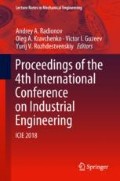Abstract
Orbital object protection against micrometeorites and orbital garbage may be realized using flexible protective panels made of polymer matrix and ceramic grains. The best protection may be performed using grains of optimal size, specific grains volume content, and appropriate materials. In the view of this, development of parametric FE models with changeable parameters is an actual problem. The adequate description of a panel composite structure is an important modeling item. Composite micro-modeling with the description of each ceramic grain provides the most adequate results. Grains scanning and following image rasterization are used to describe a composite structure instead of abstract grains modeling. The application of voxel modeling and set algebra provides the modeling of an arbitrary composite structure. Plastic kinematic material model is used as a rather simple and adequate to minify computational complexity. Model parameters have been selected using experimental data and applied to describe penetrator impact on composite panel. The research has proved the feasibility of such modeling procedure.
Access this chapter
Tax calculation will be finalised at checkout
Purchases are for personal use only
References
Christiansen E (2014) Micrometeoroid and Orbital Debris (MMOD) Risk Overview. Report N: JSC-CN-31542/ NASA In-Space Inspection Technology Workshop (ISIW 2014). Houston, TX; United States 32. https://ntrs.nasa.gov/archive/nasa/casi.ntrs.nasa.gov/20140009950.pdf
Andrenucci M, Pergola P, Ruggiero A (2011) Active removal of space debris. Expanding foam application for active debris removal, University of Pisa 132
Ridenoure R et al (2016) Testing the LightSail program: advancing solar sailing technology using a CubeSat platform. J Small Satellites 5(2):531–550
Xu M et al (2016) Static and dynamic properties of semi-crystalline polyethylene. Polymers 8(4):77–91. https://doi.org/10.3390/polym8040077
Shah QH (2009) Impact resistance of a rectangular polycarbonate armor plate subjected to single and multiple impacts. Int. J Impact Eng 36:1128–1135. https://doi.org/10.1016/j.ijimpeng.2008.12.005
Medvedovski E (2010) Ballistic performance of armour ceramics: Influence of design and structure. Part 2, Ceram Int 36:2117–2127. https://doi.org/10.1016/j.ceramint.2010.05.021
Tomczyk K et al (2014) The effect of bullet yaw on the threat level; a numerical investigation. In: Conference: personal armour systems symposium (PASS 2014) Cambridge
Rahbek DB et al (2017) Effect of composite covering on ballistic fracture damage development in ceramic plates. Int J Impact Eng 99:58–68. https://doi.org/10.1016/j.ijimpeng.2016.09.010
Jovicic J, Zavaliangos A, Ko F (2015) Numerical modeling of impact behavior of integrated gradient design composite materials. Res Gate 1–35. https://doi.org/10.13140/rg.2.1.2931.9120
Ernst G et al (2010) Multiscale progressive failure analysis of textile composites. Compos Sci Technol 70:61–72. https://doi.org/10.1016/j.compscitech.2009.09.006
Jovicic J, Zavaliangos A, Ko F (2000) Modeling of the ballistic behavior of gradient design composite armors. Composites, Part A 31:773–784. doi: http://dx.doi.org/10.1016/S1359-835X(00)00028-2
Sun W, Lin F, Hu X (2001) Computer-aided design and modeling of composite unit cells. Compos Sci Technol 61:289–299
Kim HJ, Swan CC (2003) Algorithms for automated meshing and unit cell analysis of periodic composites with hierarchical tri-quadratic tetrahedral elements. Int J Numer Meth Eng 58:1683–1711. https://doi.org/10.1002/nme.828
Özel T, Karpat Y (2007) Identification of constitutive material model parameters for high-strain rate metal cutting conditions using evolutionary computational algorithms. Mater Manufact Process 22(5):659–667. https://doi.org/10.1080/10426910701323631
Sapozhnikov SB, Shchurova EI (2017) Voxel and finite element analysis models for ballistic impact on ceramic-polymer composite panels. Proc Eng 206:182–187. https://doi.org/10.1016/j.proeng.2017.10.457
Astafurov SV et al (2014) Influence of interface properties on mechanical characteristics of metal ceramic composites. Phys Mesomech 17(4):282–291. https://doi.org/10.1134/S1029959914040055
Romanova VA et al (2005) Mesomechanical analysis of the ELASTO-PLASTIC behavior of a 3D composite-structure under tension. Comput Mech 36:475–483. https://doi.org/10.1007/s00466-005-0682-5
Ignatova AV, Kudryavtsev OA, Sapoznikov SB (2015) Eksperimentalnoe issledovanie i cislennoe modelirovanie uprugih harakteristik i procnosti poristoj keramiki (Experimental investigation and numerical modeling of elastic properties and strength of porous ceramics). PNRPU Mech Bull 4:121–137. https://doi.org/10.15593/perm.mech/2015.4.08
Uhrig M et al (2015) Numerical simulation of mechanical properties of nano particle modified polyamide 6 via RVE modeling. J Mater Sci Chem Eng 3:95–102. https://doi.org/10.4236/msce.2015.31014
Chernyuk AM (2015) Analiz metodov modelirovaniya strukturno-geometricheskikh form provodyashchikh poristykh sred (Analysis of methods of design of structurally-geometrical forms of conducting porous environments). Energy Saving. Power Eng. Energy Audit 1(132):46–53
Nachtnebel M et al (2017) 3D reconstruction of cracks in polymers—new insight into the fracture behaviour? In: Deformation and Fracture Behaviour of Polymer Materials. Chapter in Springer Series in Materials Science July 2017, pp 109–119. https://doi.org/10.1007/978-3-319-41879-7_8
Shchurova CI (2015) A methodology to design a 3D graphic editor for micro-modeling of fiber-reinforced composite parts. Adv Eng Softw 90:76–82. https://doi.org/10.1016/j.advengsoft.2015.07.001
Shchurova EI (2016) Modeling of the ceramics structure for the finite element analysis. Proc Eng 150:179–184. https://doi.org/10.1016/j.proeng.2016.06.744
LS-DYNA User’s Guide. Release 15.0. 2013. ANSYS Inc.
Harper CA (2001) Handbook of ceramics, glasses, and diamonds, McGraw-Hill, Lutherville, Maryland. https://doi.org/10.1036/0071414673
Acknowledgements
The work was supported by Act 211 Government of the Russian Federation, contract № 02.A03.21.0011.
Author information
Authors and Affiliations
Corresponding author
Editor information
Editors and Affiliations
Rights and permissions
Copyright information
© 2019 Springer Nature Switzerland AG
About this paper
Cite this paper
Shchurova, E.I. (2019). Voxel and Finite Element Modeling of the Ceramic–Polymer Composite Panel for Ballistic Impact Description. In: Radionov, A., Kravchenko, O., Guzeev, V., Rozhdestvenskiy, Y. (eds) Proceedings of the 4th International Conference on Industrial Engineering. ICIE 2018. Lecture Notes in Mechanical Engineering. Springer, Cham. https://doi.org/10.1007/978-3-319-95630-5_30
Download citation
DOI: https://doi.org/10.1007/978-3-319-95630-5_30
Published:
Publisher Name: Springer, Cham
Print ISBN: 978-3-319-95629-9
Online ISBN: 978-3-319-95630-5
eBook Packages: EngineeringEngineering (R0)

